Accommodation and Disability
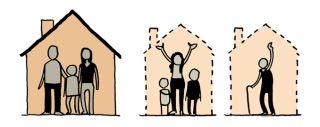
This Saturday, 3rd December 2022, is International Day of Persons with Disabilities. In this article we look at the interaction between disability and housing.
Housing Tenure
Chart 1 below shows the tenure make-up of the total population in 2021, according to Eurostat data. This shows that in Ireland, 40.7 per cent of the population were classified as owner occupiers with no mortgage; a further 31.3 per cent as owner occupiers with a mortgage; 10.1 per cent as tenants paying market rent; and 17.9 per cent as tenants paying non-market rent, which would include social housing and "social housing solutions" such as HAP, RAS and SCHEP scheme housing.
Chart 1: Tenure Status of the Population, 2021, Ireland and the EU27
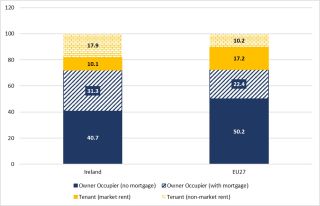
Source: Eurostat, 2022
Charts 2 and 3 show tenure by severity of physical limitation. Here, we can see that both owner occupiers without a mortgage and tenants paying non-market rent increases by severity of physical limitation, with these two tenure types accounting for more than two-thirds of all tenure types held by people with severe physical limitation.
Chart 2: Population with some activity limitation by tenure, 2021, Ireland and the EU27
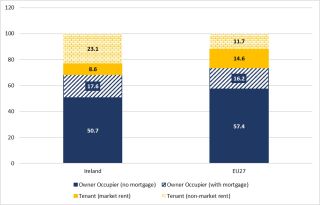
Source: Eurostat, 2022
Chart 3: Population with severe physical limitation by Tenure, 2021, Ireland and the EU27
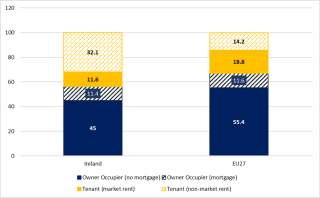
Source: Eurostat, 2022
These data have implications for housing policy for people with disabilities, from taxation policy on inherited property where the beneficiary has a disability which limits their capacity to work and where the property is their family home, to the provision of sufficient supported public and social housing.
Social Housing
Safe, secure, accessible, affordable housing is integral to all our wellbeing. According to the Summary of Social Housing Needs Assessments, 4,000 households reported, within the specific breakdown of housing requirements, a household member as having an enduring physical, sensory, mental health or intellectual disability, a decrease of 3 per cent on the previous year [1]. A breakdown of the Main Need for Social Housing Support shows that 5,602 households reported some form of disability, a decrease from 5,800 the previous year (Chart 4). However, while this number has decreased over time, it should be noted that the Summary of Social Housing Needs, or social housing waiting lists as they're more commonly called, do not include HAP or RAS tenancies or people accommodated under the SCHEP scheme (resulting in an additional c.80,000 households not included overall); they do not include households on the transfer list; they require a determination that the household is both "eligible for and in need of" social housing determined by the Local Authority; and the process can be unwieldy for anyone with literacy or numeracy difficulties or additional needs.
Chart 4: Social Housing Needs Assessments, 2013-2021, Households whose Main Need for Social Housing Support by disability
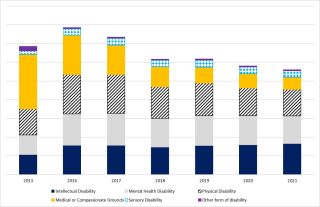
Source: Housing Agency, Summary of Housing Needs Assessments, various years
The process for applying for social housing changed in 2016, when it transferred from every three years to every year. While this has many positives, it also means that people who may require support completing forms and engaging with administrative processes are disadvantaged.
•Letter sent every year requesting details of:
•Confirmation that they were still seeking social housing support.
•Updated information (including verification documentation, as required) to ensure that they qualify or continue to qualify in accordance with the Social Housing Assessment Regulations.
•Any new household members.
•If there’s no response to the first letter, a follow up letter will be sent
•In some areas, Local Authorities will also call or text
•Advertisements reminding of the process are placed in public places and newspapers
•Information verified and, if eligible, household placed on list
•Any changes in circumstances of the household – a recent change in marital status, for instance.
•Any change to employment status.
•Income verification for all household members.
•Details of rent or mortgage supplement, if in receipt of this form of State support.
Housing Affordability
Housing affordability is a serious issue in Ireland. However, given the increased risk of poverty experienced by people with disabilities when compared to the general population (39.1 per cent compared to 11.6 per cent in 2021), it is a particular concern here.
Research by the ESRI shows that people with a disability have a higher risk of poverty before and after housing costs than people without a disability. In fact, the before-housing-cost poverty rate of those with a disability is higher than the rate after housing costs of those who do not have a disability.
The latest data from the CSO also indicates that more than two in five people who are unable to work due to a long-standing health problems (42.7 per cent) experienced enforced deprivation, compared to 17.1 per cent of the general population.
Housing Adaptation Grants
In 2021, funding was allocated or increased to a number of schemes to support housing for older people and people living with a disability. In May 2021, Ministers O’Brien and Burke announced €23 million in funding for the Disabled Persons Grant scheme (DPG) which supports adaptations and extensions to existing Local Authority housing stock, and the Improvement Works in Lieu of Local Authority Housing Scheme (IWILS) which supports improvements or extensions to private housing stock where the tenant has been approved for social housing, “meeting their social housing need” and reducing the waiting list for social housing. These schemes are important and necessary, and the increases are to be welcomed, however they are still catching up from previous years of underfunding.
While the majority (almost 69 per cent) of people living with a disability own their own home with or without a mortgage [2], 12.4 per cent are living in the private rented sector (an increase of almost 13 per cent in real numbers of persons living with a disability in the private rented sector compared to Census 2011). The IWILS scheme is only available to people who are deemed eligible for social housing, which would exclude most of the 69 per cent who are owner occupiers. There is little incentive for private landlords to modify their properties to meet the needs of tenants living with a disability or older tenants when they could attract equal or higher rents with new tenants.
Housing Adaptation Grants is the collective term given to the three grants: Housing Aid for Older People, Housing Aid for People with a Disability and Mobility Aid Grant. These grants are provided to eligible people to modify their own homes, allowing them to live at home, within their communities, for longer. Given the large proportion of people living with a disability who own their own homes, the Housing Adaptation Grants are especially important. In 2010, a total of €77.3 million was paid in respect of 13,588 grants. These grants were subject to cuts during the austerity years, and in 2013 reached their lowest point in the decade, with €37.7 million paid in respect of 7,011 grants, less than half 2010 levels. Building on moderate increases since 2015, the total amount paid in respect of these grants in 2021 was €56.5 million in respect of 10,283 grants. An improvement on 2013, but still considerably lower than 2010 levels (Table 1).
In addition, delays in accessing the necessary Occupational Therapists to certify a need for home modifications means that people living with disabilities may be at risk in their homes due to lack of necessary works.
Table 1: Housing Adaptation Grants, by Type, 2008-2021
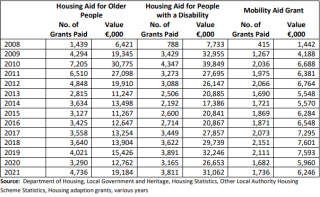
Lack of availability of grants for home modifications coupled with low income, lower levels of educational attainment (13.7 per cent had completed no more than primary education [2], compared to 4.2 per cent of the general population) and a prevalence of poverty means that those with a disability are unlikely to be able to afford adequate accommodation to support independent or assisted living. In January 2022, the Department of Housing, Local Government and Heritage published the National Housing Strategy for Disabled People 2022-2027 [3]. The stated vision for the strategy is:
To facilitate disabled people to live independently with the appropriate choices and control over where, how and with whom they live, promoting their inclusion in the community. To further enable equal access for disabled people to housing with integrated support services. This is a very welcome vision, which must be sufficiently resourced for delivery.
The new strategy is centred around six themes:
• Theme 1: Accessible Housing and Communities. This focuses on the provision of accessible housing for people living with a disability and the promotion of universal design principles.
• Theme 2: Interagency Collaboration and the Provision of Supports. This will include better collaboration between Local Authorities and the HSE, inter-departmental cooperation and information sharing between agencies.
• Theme 3: Affordability of Housing. This focuses on enabling access to affordable housing for people with disabilities.
• Theme 4: Communication and Access to Information. This aims to ensure that people with disabilities are not disadvantaged in communicating their needs and in the communication they receive.
• Theme 5: Knowledge, Capacity, and Expertise: This theme seeks to increase awareness and understanding of disability and housing within the relevant organisations, such as Local Authorities, Approved Housing Bodies, the HSE, and disability service providers. It also places an emphasis on increasing awareness regarding disabled people’s effective participation and inclusion in their communities.
• Theme 6: Strategy Alignment. This theme focuses on ensuring that all Government strategies and policies from a housing perspective promote the rights of disabled people, in line with the UN Convention on the Rights of Persons with Disabilities (UNCRPD).
These themes are all very welcome and, if delivered simultaneously could work towards providing real, sustainable housing solutions for people with disabilities. Social Justice Ireland believes that ensuring that people with a disability can live independently where possible should be a key policy priority. Providing the resources for this, including suitable housing and housing-related supports, must be one of the foundations of such a policy.
[1] https://www.gov.ie/en/publication/f6119-summary-of-social-housing-asses…
[2] https://www.cso.ie/en/csolatestnews/presspages/2017/census2016profile9-…
[3] https://assets.gov.ie/213153/a6abe06d-5651-4313-b75c-46571b2378c2.pdf